mobile View, to the German Version tap the flag


- Carinthia (Kärnten)
- Federal Country of the Republic of Austria
- former Austrian crown land: Duchy of Carinthia
• Flags
• historical Flag
• Meaning/Origin of the Flag
• Coat of Arms
• Meaning/Origin of the Coat of Arms
• Map of the federal countries of Austria
• Map of the former crown lands of Austria-Hungary (to 1918)
• Numbers and Facts
• History
• Origin of the Country's Name

Flag of the country (Colours of the country),
ratio = 2:3,
Source, by: Wikipedia (D),
Colour, by: Dr. Peter Diem www.peter-diem.at



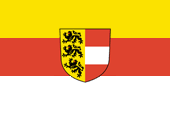
Official flag,
ratio = 2:3,
Source, by: Wikipedia (D),
Colour, by: Dr. Peter Diem www.peter-diem.at








to 1918 (–1946?),
Flag of the country (colours),
ratio = 2:3,
Quelle, nach:
Österreichisch-Ungarische Wappenrolle




The flag of Carinthia shows three stripes in gold, red and white and was
officially and lastly confirmed on the 18th of June in 1946. The colours of the
flag are derived from the colours of the the coat of arms.
In the time of the monarchy, the country had – like all the other crown lands of the Austrian crown – its own colours (Landesfarben), which were used amongst others on horizontally two- or three-striped flags. The colours (Landesfarben) were very often taken from the respective coat of arms of the country or were supplemented by another colour, which not appears in the coat of arms, or they went back to older models of the coat of arms (e.g. Carniola). Officially, the colours had never been regulated or stipulated, so that their sequence varied in practice or even the colors deviated. The Austrian heraldist Hugo Gerard Ströhl (1851–1919) was probably the first to take care of it and asked for the colors (Landesfarben) on the flags at the respective state authorities around 1890 and compiled them. For Carinthia, red and white were ascertained as the country's colors of the crown land.
Austria joined the German Empire in 1938 as one country. The federal structures played no role, they were completely replaced by the NSDAP districts (NS-Gau), the countries were abolished. From now on, offices and authorities had to use the empire's official flag. The corresponding national colors may still have exist, but not in the form of flags. They may have been used sporadically on SA uniforms or in some ranks of the Hitler Youth in the chest cord.
The flags of the Federal States of Austria are used with or without the coat of arms. For official use, however, they always show it. The general population is permitted to use this format as well.
There do not seem to be any legal regulations for the colours of the flags of the Austrian federal states; since they are apparently not defined, they are reproduced in practice within a usual standard range. However, the Austrian publicist and media scientist Dr. Peter Diem gives recommendations for the reproduction of the colours: For Carinthia, a bright red, most likely corresponding to Pantone 179, and yellow as 100% Y.
Source: Dr. Peter Diem austria-forum.org,
Wikipedia (D),
Flaggen Enzyklopädie,
Volker Preuß,
Österreichisch-Ungarische Wappenrolle

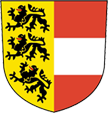
since 1930,
Coat of arms of Carinthia,
Source, by: Wikipedia (D)
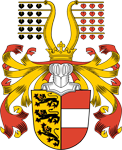
greater Coat of arms of Carinthia,
Source, by: Unknown author / Public domain via Wikipedia (D)
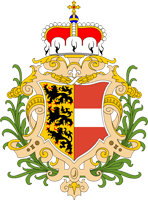
ca.1890–1918,
Coat of arms of the Duchy of Carinthia,
Source, by: Ströhl, Wappenrolle Österreich-Ungarns, 1890, via Wikipedia (D)
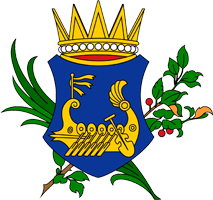
1814–1849,
Carinthia belongs to the Habsburg Kingdom of Illyria,
Source, by: Ströhl, Wappenrolle Österreich-Ungarns, 1890, via Wikipedia (D)

The today’s coat of arms of Carinthia was introduced in the year 1930. The coat of arms goes back to the 13th century. It is parted per pale: in the left field the original heraldry of Carinthia, three black lions in gold, in the right field the Austrian band-shield of the Babenberg House. The three black lions on gold go back to the Staufer Babenbergers of Moedlingen. The red-white-red Babenberg band-shield was inserted in 1246 because Duke Ulrich III. claim the inheritance to the Duchy of Austria. Despite the expiry of the claims in 1269, the coat of arms remained in this form. Carinthia is the only federal state in Austria which uses a coat of arms in the grater coat of arms variant. Until 1930 the blazon carried a crown. The crown on the coat of arms was a common princely hat at the time of the monarchy. The Austrian heraldist Hugo Gerard Ströhl surrounded the coat of arms ca. 1890, in its last known version, with for the country typical flora. For the Duchy of Carinthia this had been stylized reed leaves, which should remind of the many lakes in the country.
Source: Wikipedia (D),
Flaggen Enzyklopädie,
Österreichisch-Ungarische Wappenrolle

The federal countries of Austria:
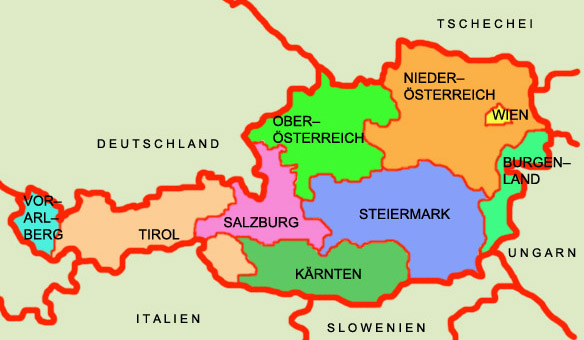
Source: Volker Preuß
• Burgenland
• Carinthia (Kärnten)
• Lower Austria (Niederösterreich)
• Upper Austria (Oberösterreich)
• Salzburg
• Styria (Steiermark)
• Tyrol (Tirol)
• Vorarlberg
• Vienna (Wien)

Map ca. 1910:
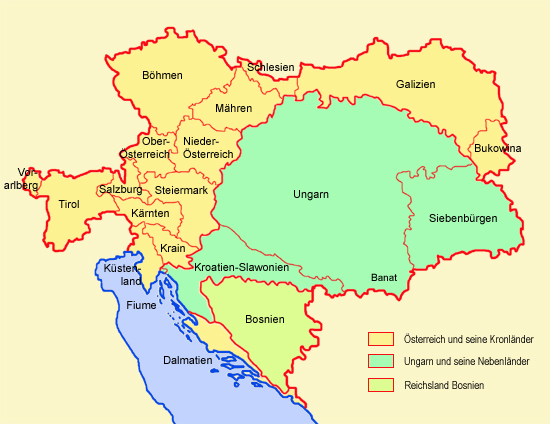
Source: Volker Preuß

Area: 3.683 km²
Inhabitants: 561.000 (2019), thereof 90% German speaking Austrians, 2% Slovenes
Density of Population: 152 Ew./km²
Capital: Klagenfurt, 100.800 inh. (2019)
official Language: German
other Language: Slovanian
Currency: 1 Euro = 100 Cent
Time Zone: MEZ
Source: Wikipedia (D)

200 B.C. · settlement by Celts
15 B.C.–46 A.D. · beginning Roman conquest, establishment of the Province of Noricum
4./5. cent. · invasion of the Goth
409–452 · invasions of the Huns
6th cent. · settlement by Slavs, especially by the Slavic tribe of the Carantanes
ca. 750 · Duke Tassilo III. of Bavaria conquers the today’s Carinthia
788 · Bavaria and Carantania (first mention of this name) becomes subjected by the Frankish Empire of the Carolingians
803 · establishment of the "Carantanian Mark"
976 · establishment of the Duchy of Carinthia, at the same time affiliation of the Marks of Istria and Carniola
1047 · the House of Welf (Swabian Guelphs) gets the title of duke (to 1055)
1077 · the House of Eppenstein gets the title of duke
1122 · the House of Sponheim gets the title of duke
1286 · the House of Goerz gets the title of duke
1335 · the House of Habsburg gets the title of duke by heritage
13th/14th cent. · settlement by Germans
1394 · Carinthia (incl. Istria) becomes an independent Duchy of Habsburg
15th cent. · invasions of the Turks
1797–1809 · French Revolutionar Wars, parts of Austria (Styria) become occupied by the French in 1797
1809 · Peace of Vienna, Austria loses Salzburg, the Inn Quarter, Western Galicia and parts of Eastern Galicia and cedes Istria, Trieste, Gorizia, Carniola, Carinthia, Croatia, and Dalmatia to France, which were merged in 1810 to the French "Illyrian Provinces"
1814 · Congress of Vienna, the Empire of Austria (House of Habsburg) acquires back the in 1809 lost territories, they become merged to the Habsburg's Kingdom of Illyria,
Carinthia becomes a part of the Habsburg's Kingdom of Illyria
1848/1849 · revolution, new constitution: the titular hereditary territories of the Habsburgs in the Austrian Empire become converted to crown lands with their own Landtag (parliament), end of the Kingdom of Illyria, the Duchy of Carinthia becomes in this way a crown land of the Austrian Empire
12th of November 1918 · proclamation of German Austria to the Republic of Austria, Carinthia becomes an Austrian federal country
10th of October 1920 · plebiscite in Southern Carinthia for the remaining at Austria and against an annexion to Yugoslavia
13th of March 1938 · annexation of Austria to the German Empire, the administrative "NS-Gau of Carinthia" takes the place of the Country of Carinthia
27th of April 1945 · proclamation of the Republic of Austria "Second Republic", Carinthia becomes again an Austrian federal country, but stays occupied by British troops until 1955
1955 · withdrawal of the occupation troops
Source: Atlas zur Geschichte,
Wikipedia (D),
World Statesmen,
RetroBib Retrobibliothek,
Discovery '97,
Volker Preuß

The name "Carinthia" (in German: "Kaernten") has its roots in the denomination of the Celtic mountain residents, the "Carners". That name was even transfered to the later immigrated Slavs which named itself "Carantanians". "Carinthia/Kaernten" is ergo a short form of "Carantania".
Source: Handbuch der geographischen Namen

Further Austria pages (historical flags and coats of arms):
• Empire of the Austrian Habsburgs (to 1804)
• Empire of Austria (1814–1867)
• Austria-Hungary (1867–1918)
• Republic of Austria (since 1918)

![]()

















